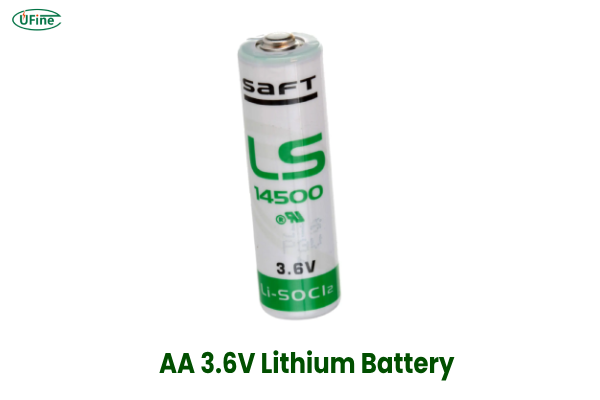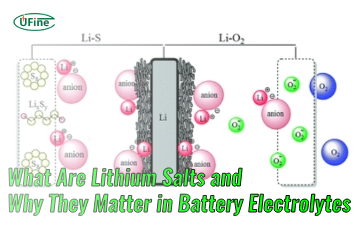When it comes to reliable, high-performance power sources, the AA 3.6V lithium battery is in a league of its own. Unlike standard 1.5V alkaline batteries, this powerhouse delivers higher voltage, superior energy density, and exceptional longevity—making it indispensable for demanding applications.
But what exactly makes this battery so special? How does it compare to alternatives? And where should you use it? In this comprehensive guide, we’ll dive deep into every aspect of the 3.6V lithium AA battery, from its technical specifications to real-world applications.
Part 1. Understanding the AA 3.6V lithium battery

What Makes It Different?
Most consumers are familiar with 1.5V alkaline AA batteries, but the 3.6V lithium variant operates on a completely different level. Here’s why:
-
Higher Voltage Output: While alkaline AAs provide 1.5V, lithium AAs deliver 3.6V, making them ideal for high-drain electronics.
-
Chemistry Matters: These batteries typically use lithium iron disulfide (Li-FeS₂) or lithium manganese dioxide (Li-MnO₂), enabling higher energy density and thermal stability.
-
Longer Shelf Life: Unlike alkalines, which degrade quickly, lithium AAs can last up to 10 years in storage with minimal power loss.
Primary vs. Rechargeable Variants
Most 3.6V lithium AA batteries are non-rechargeable (primary cells), designed for single-use applications. However, rechargeable 14500 Li-ion batteries (3.7V) are sometimes marketed as substitutes—though they are not exact equivalents.
Key Takeaway: If you need long-term reliability in extreme conditions, a primary lithium AA is the best choice. For frequent reusability, a Li-ion 14500 may work—but with trade-offs.
AA vs C vs D battery: A Comprehensive Comparison
Part 2. Key technical parameters explained in detail
Voltage: Why 3.6V?
The 3.6V nominal voltage is a defining feature. But why this specific rating?
-
Efficiency in High-Drain Devices: Many medical, industrial, and photographic devices require stable, high voltage for optimal performance.
-
Discharge Curve: Unlike alkaline batteries, which gradually lose voltage, lithium AAs maintain near-constant voltage until depletion.
Dimensions & Compatibility
-
Standard AA Size (14.5mm x 50.5mm): Ensures compatibility with most AA battery compartments.
-
Weight (~15g): Lighter than NiMH or alkaline AAs, making them ideal for portable electronics.
Capacity & Energy Density
-
Typical Capacity: Ranges from 1200mAh to 3000mAh, far exceeding alkaline AAs (typically 800-2400mAh).
-
Energy Density: Lithium AAs store more energy per gram, crucial for weight-sensitive applications like aerospace and military gear.
Operating Temperature Range
One of the biggest advantages? Extreme temperature resilience.
-
-40°C to 60°C Performance: Unlike alkalines, which fail in freezing conditions, lithium AAs remain functional in Arctic cold or desert heat.
Part 3. Battery Chemistry
Lithium Iron Disulfide (Li-FeS₂) vs. Lithium Manganese Dioxide (Li-MnO₂)
-
Li-FeS₂: Common in consumer-grade lithium AAs, offering high energy output and long shelf life.
-
Li-MnO₂: Used in industrial/military applications, prized for thermal stability and high discharge rates.
Why Lithium?
-
Low Self-Discharge: Loses only 1-2% charge per year, compared to ~20% for alkalines.
-
No Memory Effect: Unlike NiMH batteries, lithium AAs don’t need full discharge cycles.
Part 4. Advantages & Disadvantages
Advantages
✅ Superior Lifespan – Lasts 5-10x longer than alkaline in high-drain devices.
✅ Lightweight – Critical for wearable tech and aviation equipment.
✅ Wider Temperature Tolerance – Works in freezing winters or scorching summers.
✅ Leak-Resistant – Unlike alkalines, lithium AAs rarely leak, protecting expensive electronics.
Disadvantages
❌ Higher Cost – 2-3x pricier than alkalines, but justified by performance.
❌ Non-Rechargeable (Mostly) – Single-use only; rechargeable alternatives require careful handling.
❌ Voltage Incompatibility – Not all devices support 3.6V; always check specifications.
Part 5. AA 3.6V lithium battery vs. 14500 battery: key differences explained
If you’re comparing a 3.6V lithium AA battery and a 14500 battery, you might wonder: Are they the same? Can they be used interchangeably? The short answer is no—they have critical differences that affect performance and safety.
🔋 Voltage & Chemistry
| Feature | 3.6V Lithium AA | 14500 Battery |
|---|---|---|
| Nominal Voltage | 3.6V (Li-FeS₂ or Li-MnO₂) | 3.7V (Li-ion or LiFePO₄) |
| Rechargeable? | Usually non-rechargeable (primary cell) | Rechargeable (secondary cell) |
| Chemistry | Lithium iron disulfide (Li-FeS₂) or lithium manganese dioxide (Li-MnO₂) | Lithium-ion (Li-ion) or lithium iron phosphate (LiFePO₄) |
Key Takeaway:
-
3.6V AA lithium is optimized for single-use, long-term storage, and extreme conditions.
-
14500 batteries are rechargeable but require careful handling (overcharging risks fire).
📏 Physical Dimensions
Both share the same size (14.5mm x 50.5mm), meaning they fit in AA slots. However:
-
3.6V lithium AA is designed as a direct alkaline replacement (but with higher voltage).
-
14500 batteries are Li-ion cells often used in flashlights and vaping devices.
⚡ Performance & Use Cases
| Factor | 3.6V Lithium AA | 14500 Battery |
|---|---|---|
| Best For | Medical devices, industrial sensors, emergency backup | High-drain flashlights, vaping mods, custom electronics |
| Cycle Life | Single-use | 300-500 recharge cycles |
| Energy Density | High (~3000mAh) | Varies (600-1200mAh for Li-ion) |
| Safety Risks | Minimal (sealed, stable chemistry) | Higher (thermal runaway risk if mishandled) |
⚠️ Can You Swap Them?
Not always!
-
If a device requires 3.6V lithium AA, using a 3.7V 14500 might work—but could overload circuits.
-
If a device expects 1.5V (alkaline), NEVER use either—both will deliver excessive voltage and may cause damage.
💡 Practical Recommendation
-
Use 3.6V lithium AA for critical, long-life applications (e.g., medical equipment).
-
Use 14500 for custom electronics or rechargeable needs—but only if voltage compatibility is confirmed.
Part 6. Applications
Medical Devices
-
Glucose meters, digital thermometers, hearing aids – Reliability is critical, and lithium AAs deliver.
Photography & Electronics
-
Digital cameras, professional flash units – High voltage ensures faster recycling and brighter flashes.
Industrial & Military Use
-
Sensors, GPS trackers, tactical flashlights – Performs in harsh environments where other batteries fail.
Emergency & Backup Power
-
Smoke detectors, emergency radios – Long shelf life means dependability in crises.
Part 7. 1.5V lithium AA vs. 3.6V lithium AA: which should you choose?
| Feature | 1.5V Lithium AA | 3.6V Lithium AA |
|---|---|---|
| Voltage | 1.5V (Standard) | 3.6V (High-Power) |
| Best For | Low-drain devices (clocks, remotes) | High-drain devices (medical, industrial) |
| Runtime | Good | Exceptional |
| Cost | Affordable | Premium |
When to Use Which?
-
Choose 1.5V for everyday gadgets.
-
Opt for 3.6V if your device demands higher voltage and endurance.
Part 8. Can you recharge a 3.6V lithium AA?
Short Answer: No, most are single-use. However:
-
Rechargeable 14500 Li-ion (3.7V) batteries exist but aren’t direct replacements.
-
Attempting to recharge a primary lithium AA can cause leaks or explosions.
Part 9. Replacement options
If unavailable, consider:
-
Two 1.5V lithium AAs in series (if the device supports 3V).
-
A 14500 Li-ion battery (3.7V, rechargeable) – But verify voltage compatibility.
-
Specialty lithium packs for industrial applications.
Warning: Never mix battery chemistries!
Part 10. Where to buy 3.6V lithium AA batteries
-
Online Retailers: Amazon, eBay (stick to reputable brands like Energizer, Panasonic, or Ultralife).
-
Electronics Stores: Best Buy, Fry’s (if available).
-
Industrial Suppliers: For bulk orders.
Pro Tip: Beware of counterfeit batteries—always check reviews and seller ratings.
Part 11. Is the 3.6V lithium AA right for you?
If you need long-lasting, high-performance power in extreme conditions, the 3.6V lithium AA battery is unmatched. While the higher cost may deter casual users, professionals in medical, industrial, and photography fields will find it indispensable.
Before buying:
✔ Check device compatibility
✔ Verify if rechargeability is needed
✔ Purchase from trusted suppliers
With this guide, you’re now equipped to make an informed decision—whether you’re powering a critical medical device or a high-end camera flash.
Part 12. FAQ
Can I use a 3.6V lithium AA in place of a 1.5V alkaline?
No! The higher voltage can damage electronics not designed for it.
How do I store lithium AA batteries for maximum lifespan?
Keep them in a cool, dry place (20°C or lower). Avoid extreme heat.
Are these batteries safe for air travel?
Yes, but airlines may limit quantities. Check IATA guidelines.
What’s the best brand for 3.6V lithium AAs?
Top performers: Energizer Ultimate Lithium, Panasonic Lithium, and Duracell Lithium.
Why does my device specify a 3.6V lithium AA?
Likely because it requires stable high voltage—alkalines can’t meet that demand.
Related Tags:
More Articles

What Are Lithium Salts and Why They Matter in Battery Electrolytes
Lithium salts in electrolytes are key to battery performance, powering everything from phones to EVs and shaping the future of clean energy.
Lithium AAA Battery Guide: Power, Performance & Chargers
Explore lithium AAA batteries—voltage, capacity, weight, top brands, and more. Learn how to choose the best battery for your device and why it really matters.
How to Calculate Watts, Volts, and Amps (With Simple Formulas and Examples)
Learn how to calculate watts, volts, and amps for lithium batteries with simple formulas and examples, ideal for EVs, solar, and energy systems.
Comprehensive Analysis of U.S. Tariffs on Chinese Lithium Batteries
U.S. tariffs on Chinese lithium batteries in 2025 impact costs, supply chains, and EV, energy storage, and electronics industries globally.
What Are Lithium Button Batteries?
Learn about lithium button batteries (CR2032, CR2025), their uses, safety tips, and how to replace them properly.



